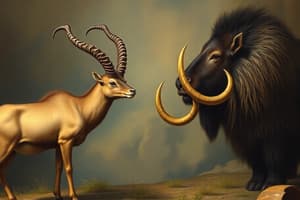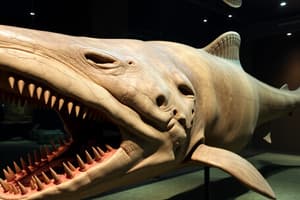Podcast
Questions and Answers
What is the primary purpose of a dichotomous key?
What is the primary purpose of a dichotomous key?
- To analyze the genetic makeup of organisms
- To illustrate food chains among species
- To identify organisms through a series of choices (correct)
- To classify organisms into hierarchical categories
Which level of classification directly groups organisms based on shared derived characteristics?
Which level of classification directly groups organisms based on shared derived characteristics?
- Phylum
- Clade (correct)
- Kingdom
- Order
What does binomial nomenclature allow for in scientific classification?
What does binomial nomenclature allow for in scientific classification?
- A unique two-part naming system for each species (correct)
- The ranking of organisms by their common names
- The systematic grouping of organisms with similar habitats
- The classification of organisms by color and size
Why can common names be misleading in scientific classification?
Why can common names be misleading in scientific classification?
What aspect of phylogeny is emphasized in the study of evolutionary history?
What aspect of phylogeny is emphasized in the study of evolutionary history?
What does the term 'extinct' refer to?
What does the term 'extinct' refer to?
What is the primary purpose of relative dating?
What is the primary purpose of relative dating?
How does half-life relate to radioactive isotopes?
How does half-life relate to radioactive isotopes?
What does the Geological Time Scale illustrate?
What does the Geological Time Scale illustrate?
What distinguishes an era from a period in the Geological Time Scale?
What distinguishes an era from a period in the Geological Time Scale?
What does the theory of plate tectonics explain?
What does the theory of plate tectonics explain?
What characterizes a mass extinction event?
What characterizes a mass extinction event?
Why are there gaps in the fossil record?
Why are there gaps in the fossil record?
What typically occurs during a mass extinction?
What typically occurs during a mass extinction?
Which of the following best defines a niche?
Which of the following best defines a niche?
What does the location of a fossil indicate about its age?
What does the location of a fossil indicate about its age?
How do plate tectonics explain changes to the Earth's surface?
How do plate tectonics explain changes to the Earth's surface?
What methods do scientists use to define geological eras?
What methods do scientists use to define geological eras?
What were the primary components of Earth's early atmosphere?
What were the primary components of Earth's early atmosphere?
What did the Stanley Miller experiment simulate?
What did the Stanley Miller experiment simulate?
Which aspect does the endosymbiosis theory explain?
Which aspect does the endosymbiosis theory explain?
What evidence supports the endosymbiosis theory?
What evidence supports the endosymbiosis theory?
How did photosynthesis impact Earth's atmosphere?
How did photosynthesis impact Earth's atmosphere?
Which factor primarily influences climate zones?
Which factor primarily influences climate zones?
What is a climograph used for?
What is a climograph used for?
What differentiates a population from a community in ecology?
What differentiates a population from a community in ecology?
What do biomes primarily reflect?
What do biomes primarily reflect?
What is the primary purpose of taxonomy?
What is the primary purpose of taxonomy?
Flashcards
Extinct Species
Extinct Species
A species that no longer exists on Earth.
Relative Dating
Relative Dating
Determining the age of rocks/fossils compared to others, not the exact age.
Fossil Record
Fossil Record
Evidence of past life, often found in sedimentary rock.
Half-life
Half-life
Signup and view all the flashcards
Geological Time Scale
Geological Time Scale
Signup and view all the flashcards
Mass Extinction
Mass Extinction
Signup and view all the flashcards
Plate Tectonics
Plate Tectonics
Signup and view all the flashcards
Endosymbiotic Theory
Endosymbiotic Theory
Signup and view all the flashcards
Binomial Nomenclature
Binomial Nomenclature
Signup and view all the flashcards
Taxonomy
Taxonomy
Signup and view all the flashcards
Genus, in classification
Genus, in classification
Signup and view all the flashcards
Clade
Clade
Signup and view all the flashcards
Derived character
Derived character
Signup and view all the flashcards
Niche
Niche
Signup and view all the flashcards
Fossil age
Fossil age
Signup and view all the flashcards
Geological eras
Geological eras
Signup and view all the flashcards
Early atmosphere
Early atmosphere
Signup and view all the flashcards
Miller-Urey experiment
Miller-Urey experiment
Signup and view all the flashcards
Endosymbiosis
Endosymbiosis
Signup and view all the flashcards
Endosymbiosis evidence
Endosymbiosis evidence
Signup and view all the flashcards
Photosynthesis's impact
Photosynthesis's impact
Signup and view all the flashcards
Biosphere
Biosphere
Signup and view all the flashcards
Ecology
Ecology
Signup and view all the flashcards
Genus
Genus
Signup and view all the flashcards
Study Notes
History of Life and the Present Biosphere
- Extinct Species: Species no longer existing on Earth.
- Relative Dating: Determining the age of rocks/fossils relative to each other (older/younger).
- Half-life: Time for half of a radioactive isotope to decay, aids in dating fossils.
- Geological Time Scale: System showing Earth's history, with eras and periods.
- Plate Tectonics: Theory explaining Earth's surface movement, causing geological changes.
- Mass Extinction: Widespread, rapid decrease in biodiversity, significant extinction of species.
- Endosymbiotic Theory: Explains origin of mitochondria and chloroplasts through symbiotic relationship.
- Fossil Record: Provides info about organisms' structure, behavior, environment, and evolution.
- Fossil Locations: Often found in sedimentary rock (shale, limestone, sandstone).
- Fossil Information: Reveals organism structure, behaviour, environment, and evolutionary history.
- Fossil Record Gaps: Gaps exist due to incomplete fossilization and undiscovered fossils.
- Fossil Record Changes: Reveals species changes and environmental shifts (temperature, climate, habitat).
- Mass Extinction Causes: Often linked to catastrophic events (asteroid impacts, volcanism).
- Mass Extinction Effects: Loss of species and significant reduction in biodiversity.
- Niche: An organism's role within an ecosystem - habitat, food, interactions.
- Fossil Location & Time: Fossils in deeper rock layers are older.
- Earth's Changing Surface & Plate Tectonics: Explains continent movement, mountain formation, earthquakes, and volcanic activity.
- Geological Time Scale Eras: Determined using fossil evidence, radiometric dating, and geological features.
- Early Atmosphere Composition: Likely water vapor, CO2, nitrogen, methane, and ammonia.
- Stanley Miller Experiment: Simulated early Earth conditions, showing amino acid formation.
- Miller-Urey Experiment: Demonstrated synthesis of organic compounds in early Earth's atmosphere.
The Biosphere
- Biosphere: Part of Earth with life—Land, water, and atmosphere.
- Ecology: Study of organism/environment interactions.
- Species: Group of interbreeding organisms producing fertile offspring.
- Population: Group of same-species individuals in same area.
- Community: All different populations in an area interacting.
- Ecosystem: Community and its physical environment.
- Biotic Factors: Living parts of an ecosystem (plants, animals).
- Abiotic Factors: Non-living parts (temperature, water, sunlight).
- Atmosphere: Earths' gas layer, important for life.
- Geosphere: Solid Earth part (rocks, minerals).
- Climate: Long-term average weather conditions.
- Weather: Short-term atmospheric conditions.
- Climatograph: Graph of average temperature and precipitation.
- Biome: Large geographical community defined by climate and organisms.
- Permafrost: Permanently frozen ground in tundra.
- Four Spheres Interaction: Biosphere, atmosphere, geosphere and hydrosphere interact via cycles (carbon, water).
- Climate Zones: Tropical, temperate, and polar based on latitude, influencing climate.
- Latitude/Longitude: Affect climate due to sunlight angle variations, time zones.
- Population, Community, Ecosystem: Interrelated concepts of organisms in their environment.
- Biomes & Climate: Variations in climate create diverse biomes with unique species.
- Ecosystems within Biomes: Localized environments within a larger biome.
- Climatogram Use: Identify climate and biome based on temperature and precipitation data.
Biodiversity and Classification
- Taxonomy: Science of classifying organisms based on shared traits.
- Binomial Nomenclature: Two-part naming system (genus and species).
- Genus: Group of closely related species (first part of binomial).
- Taxon: Group of organisms in a classification system.
- Family, Class, Order, Phylum, Kingdom: Hierarchical classification levels.
- Phylogeny: Evolutionary history of a species or group.
- Clade: Group including a common ancestor and its descendants.
- Derived Character: Trait evolved within a lineage and shared by members of a clade.
- Cladogram: Diagram illustrating evolutionary relationships via traits.
- Dichotomous Key: Tool for identifying organisms using choices.
- Common Names Confusion: Regional/language differences make them confusing.
- Binomial Nomenclature Use: Give unique names to each species.
- Taxonomy Use: Organize and understand species relationships.
- Genus Significance: Groups organisms with common ancestor and significant traits.
Studying That Suits You
Use AI to generate personalized quizzes and flashcards to suit your learning preferences.





